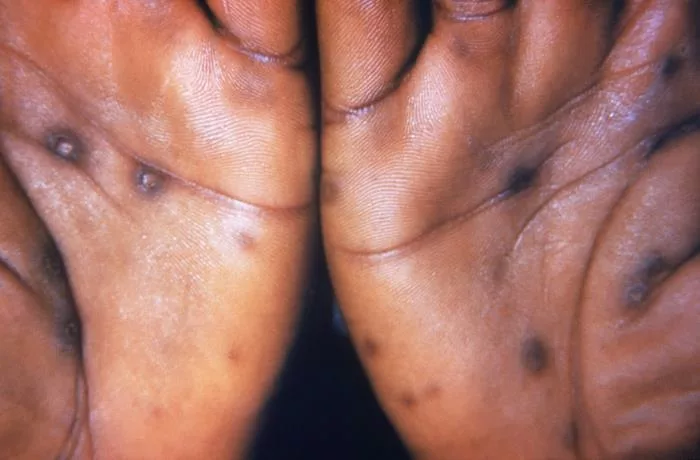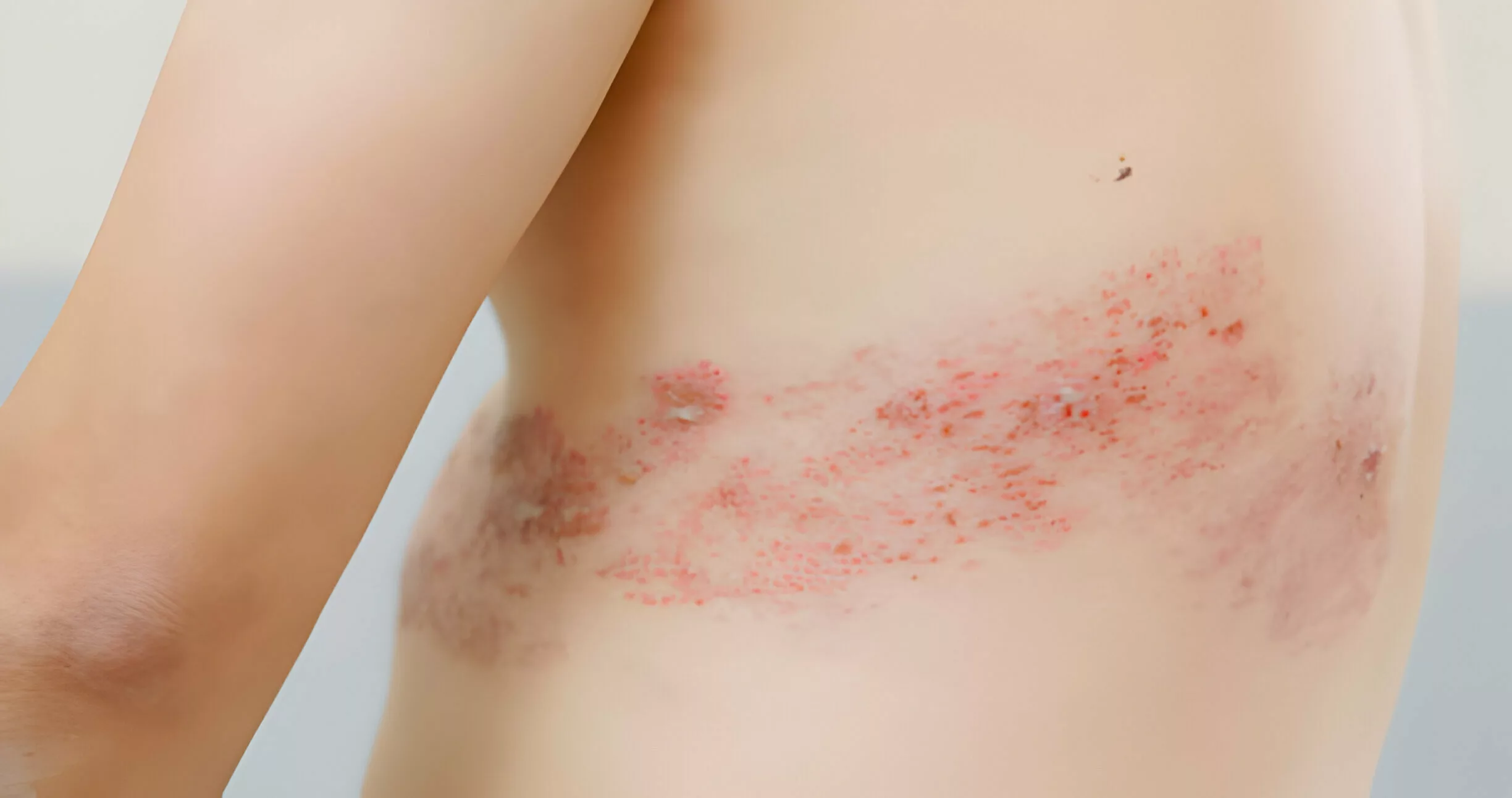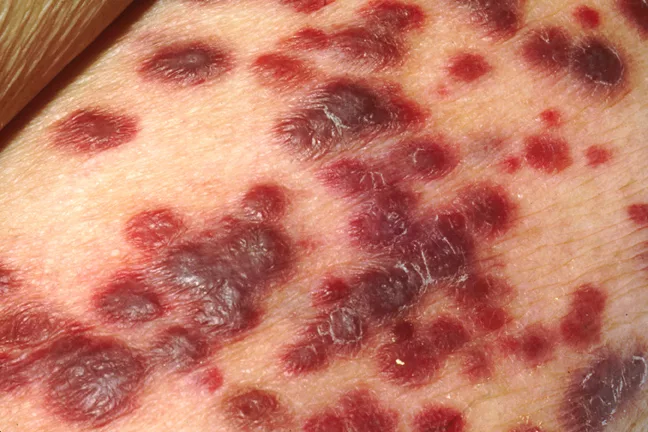What is an HIV Rash?
HIV is a virus that attacks and weakens the host’s immune system. If untreated, it can lead to AIDs (Acquired Immunodeficiency Syndrome). Most people with HIV get a rash. HIV rash can be itchy, red, or purple. It may have small raised bumps, scales, or blisters. For many people, this may be the first sign of HIV infection, though it can also occur in the later stages of HIV. It generally affects the face, neck, and trunk and may spread to hands and feet. There is no single rash that is exclusive to HIV. Due to the impact of HIV on the immune system, it can lead to a range of skin reactions.
Types of HIV Rash
These rashes can be due to multiple reasons like reactions to certain drugs, infections from other microbes, or HIV infection.
Acute HIV Rash
This rash generally occurs on your hand, feet, or trunk. It is reddish for light-skinned individuals and may take a purple hue for darker-skinned people. This rash happens when your body tries to fight off HIV. It usually appears two to six weeks after infection. It is a “maculopapular” rash. Maculopapular rashes are flat, reddened patches on the skin covered with small, elevated bumps. Doctors prescribe topical hydrocortisone creams to treat the itchiness associated with severe rashes.1Altman K, Vanness E, Westergaard RP. Cutaneous Manifestations of Human Immunodeficiency Virus: a Clinical Update. Current Infectious Disease Reports. 2015;17(3). doi:https://doi.org/10.1007/s11908-015-0464-y Other acute symptoms that you should watch out for include:
- Fever and fatigue
- Swollen lymph nodes
- Headache
- Muscle aches
- Sore throat
- Diarrhea
Symptoms generally disappear after a couple of weeks.2Cowan EA, McGowan JP, Fine SM, et al. Diagnosis and Management of Acute HIV. Johns Hopkins University; 2021. https://www.ncbi.nlm.nih.gov/books/NBK563020/ If HIV is diagnosed, antiretroviral therapy is started.
Rash by Drug Reactions
Certain antiretroviral drugs used for HIV may lead to hypersensitivity reactions. Most commonly, Abacavir and Nevirapine cause such reactions. These drugs are sold under the brand names Ziagen and Viramune, respectively.3Yunihastuti E, Widhani A, Karjadi TH. Drug hypersensitivity in human immunodeficiency virus-infected patient: challenging diagnosis and management. Asia Pacific Allergy. 2014;4(1):54. doi:https://doi.org/10.5415/apallergy.2014.4.1.54 The rash from these drugs is usually “morbilliform” and tends to occur one or two weeks after the start of treatment. Morbilliform rashes are rose-red, slightly elevated, circular lesions interrupted by healthy skin. The rash generally will appear on your torso before spreading to your arms and legs. In case of such a reaction, your physician will stop treatment and may prescribe Antihistamines. Antihistamines can reduce the redness and swelling associated with the rash.
Other drugs that may cause such a reaction include Raltegravir, Maraviroc, and medications containing Dolutegravir. However, if you experience fever, painful red or purplish rash, and blisters on your skin and around your mouth, nose, and eyes, seek medical help immediately. These may be signs of Stevens-Johnson syndrome (SJS), a rare but potentially lethal drug complication. Approximately 5% of people die from SJS.4 Worswick S, Cotliar J. Stevens-Johnson syndrome and toxic epidermal necrolysis: a review of treatment options. Dermatologic Therapy. 2011;24(2):207-218. doi:https://doi.org/10.1111/j.1529-8019.2011.01396.x Emergency care includes IV fluids, antibiotics, and medications to prevent eye damage.
Rash due to Other Infections
HIV wears down your immune system, especially the cells that help you fight infection. People who don’t take their HIV medication experience ‘Opportunistic infections.’ Many of these infections cause rashes and other dermatological signs and symptoms. These infections can include:
Syphilis
Syphilis,5Syphilis – STD information from CDC. www.cdc.gov. Published October 18, 2022. Accessed April 8, 2023. https://www.cdc.gov/std/syphilis/default.htm#:~:text=Syphilis%20can%20have%20very%20serious%20complications%20when%20left%20untreated.&text=You%20should%20get%20tested%20regularly when not treated, may lead to a non-itchy rash on the soles of your feet and the palms of your hand. This rash appears 2 to 8 weeks after infection.

Molluscum Contagiosum
Molluscum Contagiosum6Molluscum Contagiosum. Centers for Disease Control and Prevention. Published 2019. https://www.cdc.gov/poxvirus/molluscum-contagiosum/index.html is a contagious viral skin infection that causes small flesh-colored bumps on your body. The disease generally spares the soles of your feet and the palm of your hand. It resolves on its own usually, though people with HIV rash may have harder-to-treat bumps. It can spread via used towels, skin-to-skin contact, and even touching the same object.
Herpes Virus
Herpes Zoster (Shingles)7Centers for Disease Control and Prevention. Published 2019. https://www.cdc.gov/shingles/about/index.html is common in people with HIV and AIDs. It causes painful skin rashes that cover your torso, arms, and legs. It may even cover one side of your body. These rashes look like strips of water blisters. Shingles can cause permanent damage to your eyes, so get treated promptly. Herpes rashes also may appear near the mouth and genitals. Antivirals and Pain relievers can make you feel better and treat the infection.

Kaposi Sarcoma
This is a type of skin cancer that occurs in patients with HIV. It is very aggressive and spreads quickly, though it can be treated effectively with cART(combination antiretroviral therapy). Lesions can be red, purple, or brown and may appear as bumps, nodules, or patches called plaques.8Signs and Symptoms of Kaposi Sarcoma. www.cancer.org. https://www.cancer.org/cancer/kaposi-sarcoma/detection-diagnosis-staging/signs-symptoms.html#:~:text=Kaposi%20sarcoma%20(KS)%20usually%20appears

Seborrheic Dermatitis
A common and non-contagious skin condition that usually happens to oily parts of the body. It is characterized by red, scaly patches and stubborn dandruff. This condition mainly affects your scalp. Most commonly occurs on the face, sides of the nose, eyebrows, and eyelids.9Seborrheic Dermatitis and Dandruff: A Comprehensive Review. Journal of Clinical and Investigative Dermatology. 2015;3(2). doi:https://doi.org/10.13188/2373-1044.1000019 7) For information on Syphilis, Herpes, and Molluscum:
The condition usually affects over 80% of people with advanced HIV rashes. Non-HIV-infected people may also sometimes suffer from this condition. In severe cases, there are scaly pimples around your face and behind your ears. It may also affect the armpits and the inside of the ear. Your physician may use topical steroids for severe cases.10Altman K, Vanness E, Westergaard RP. Cutaneous Manifestations of Human Immunodeficiency Virus: a Clinical Update. Current Infectious Disease Reports. 2015;17(3). doi:https://doi.org/10.1007/s11908-015-0464-y
When should you see a Doctor?
Many of the conditions described above look like other common conditions, like the flu or allergies. Moreover, many of these conditions resolve quickly. Hence, many people don’t realize that there may be signs of an HIV rash.
If you think that you may have been exposed to HIV via unprotected sexual intercourse, contaminated needles, or used shaving razors, then don’t wait. Blood tests for HIV are highly accurate and sensitive. The quicker you get diagnosed, the sooner your doctors can begin treatment. Remember, HIV is no longer a death sentence, and people with the disease can help you stay healthy and longer.
Rash Treatments
HIV rashes are treated by targeting the root cause. The treatments for HIV rashes depend on the cause and severity. Hence, your physician must rule out any other cause. Rashes due to HIV may require antiretroviral therapy to prevent the infection from progressing to AIDs. It can reduce your risk of spreading the virus. These medications do a great job of suppressing the viral load (reducing the amount of HIV in your blood). Rashes due to drug reactions generally go away after the cessation of that drug and a different treatment regimen. Antivirals may be given for rashes due to viral infections, etc. Over-the-counter medications, like antihistamines or hydrocortisone, can relieve itching. Some lifestyle changes that can help include:
- Staying out of direct sunlight
- Avoiding hot showers or baths
Prompt medical attention may be required if:
- The rash rapidly spreads.
- Swollen lymph nodes or a fever accompany the rash.
- Additional symptoms are present.
How long does an HIV rash last?
HIV rash generally lasts one to two weeks after contracting the infection. The rash sometimes goes away without treatment.
At which stage of HIV does the rash appear?
The rash can appear in the early or acute stages of HIV. Symptoms appear within the first two months of being infected with the virus.
Where does HIV rash occur?
The usual location for HIV rash is your face, neck, upper back, and chest. However, it can also spread to other parts of the body.11Altman K, Vanness E, Westergaard RP. Cutaneous Manifestations of Human Immunodeficiency Virus: a Clinical Update. Current Infectious Disease Reports. 2015;17(3). doi:https://doi.org/10.1007/s11908-015-0464-y
How can we differentiate between HIV rash and other rashes?
HIV rashes appear slightly elevated from the skin. They usually appear purplish in dark-skinned individuals and reddish in light-skinned individuals.
Are there any other conditions that can cause rashes during HIV?
HIV weakens the immune system and hence can lead to a variety of infections and conditions that can cause rashes, such as:
In summary, an HIV rash serves as an early indicator of HIV infection and may occur throughout the progression of the disease. Typically appearing as reddish or purplish raised bumps or blisters, it commonly affects the face, neck, and trunk. Prompt medical attention is crucial if the rash spreads rapidly, accompanies swollen lymph nodes or fever, or presents with additional symptoms. Treatment approaches vary based on the underlying cause, ranging from antiretroviral therapy to managing specific infections or drug reactions. Early diagnosis through HIV testing is vital for timely intervention. While HIV rashes usually resolve within one to two weeks, comprehensive healthcare management is essential for optimal patient care.
Refrences
- 1Altman K, Vanness E, Westergaard RP. Cutaneous Manifestations of Human Immunodeficiency Virus: a Clinical Update. Current Infectious Disease Reports. 2015;17(3). doi:https://doi.org/10.1007/s11908-015-0464-y
- 2Cowan EA, McGowan JP, Fine SM, et al. Diagnosis and Management of Acute HIV. Johns Hopkins University; 2021. https://www.ncbi.nlm.nih.gov/books/NBK563020/
- 3Yunihastuti E, Widhani A, Karjadi TH. Drug hypersensitivity in human immunodeficiency virus-infected patient: challenging diagnosis and management. Asia Pacific Allergy. 2014;4(1):54. doi:https://doi.org/10.5415/apallergy.2014.4.1.54
- 4Worswick S, Cotliar J. Stevens-Johnson syndrome and toxic epidermal necrolysis: a review of treatment options. Dermatologic Therapy. 2011;24(2):207-218. doi:https://doi.org/10.1111/j.1529-8019.2011.01396.x
- 5Syphilis – STD information from CDC. www.cdc.gov. Published October 18, 2022. Accessed April 8, 2023. https://www.cdc.gov/std/syphilis/default.htm#:~:text=Syphilis%20can%20have%20very%20serious%20complications%20when%20left%20untreated.&text=You%20should%20get%20tested%20regularly
- 6Molluscum Contagiosum. Centers for Disease Control and Prevention. Published 2019. https://www.cdc.gov/poxvirus/molluscum-contagiosum/index.html
- 7Centers for Disease Control and Prevention. Published 2019. https://www.cdc.gov/shingles/about/index.html
- 8Signs and Symptoms of Kaposi Sarcoma. www.cancer.org. https://www.cancer.org/cancer/kaposi-sarcoma/detection-diagnosis-staging/signs-symptoms.html#:~:text=Kaposi%20sarcoma%20(KS)%20usually%20appears
- 9Seborrheic Dermatitis and Dandruff: A Comprehensive Review. Journal of Clinical and Investigative Dermatology. 2015;3(2). doi:https://doi.org/10.13188/2373-1044.1000019 7) For information on Syphilis, Herpes, and Molluscum:
- 10Altman K, Vanness E, Westergaard RP. Cutaneous Manifestations of Human Immunodeficiency Virus: a Clinical Update. Current Infectious Disease Reports. 2015;17(3). doi:https://doi.org/10.1007/s11908-015-0464-y
- 11Altman K, Vanness E, Westergaard RP. Cutaneous Manifestations of Human Immunodeficiency Virus: a Clinical Update. Current Infectious Disease Reports. 2015;17(3). doi:https://doi.org/10.1007/s11908-015-0464-y

